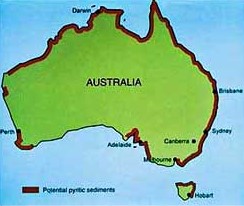Potential Acidic Sulphate Soils
Look to buy a block on a coastal plain, alongside a river, or a reclaimed wetland and you may see the area described as Potential Acidic Sulphate Soil (PASS).
Well PASS doesn’t mean OK!

Risk of PASS
Why, And Where It Occurs
These types of soil generally occur in areas which were flooded by seawater within the last 10,000 years.
During that time sediments containing iron and organic matter were deposited. Bacteria then living in the sediment was able to produce hydrogen sulfide which then reacted with the iron to form iron sulfide (pyrite).
This Australian Gov’t map shows coastal areas with a risk of PASS.
Acicidic sulphate soils have however been found in inland areas such as along the River Murray.
Problems
Draining the Soil
Pyrite is chemically stable unless it is exposed to air; such as when it is drained, or excavation takes place. (or even a prolonged drought)
Exposure to air means the pyrite oxidises and produces sulphuric acid and a range of other chemicals including the toxic hydrogen sulfide gas.
Release of the suphuric acid is likely to cause significant environmental damage over long periods as the strong acid can be released from soil for more than 50 years from the original exposure.
Because of the environmental issues all Australian States have management controls for areas of potential acidic sulphate soils
Damage to Foundations
Acid released from the soil can attack both the concrete, and the steel reinforcement within the concrete weakening the house foundation and the cement within the brick walls
Low Load Bearing Capacity
Many potential acid sulfate soils are weak clays that have not fully consolidated, and are likely to further subside or settle.
Precautions When Building
- Deep, expensive, piles will normally be required to support your foundations.
- Sulphate Resisting Cement should be used in all concrete.
- Extra care will need to be taken to ensure all concrete is protected from groundwater by a heavy duty plastic layer.